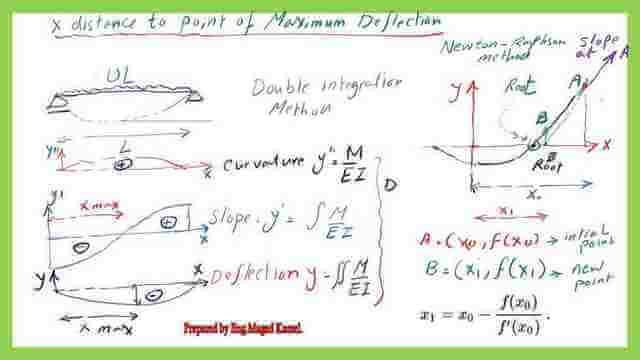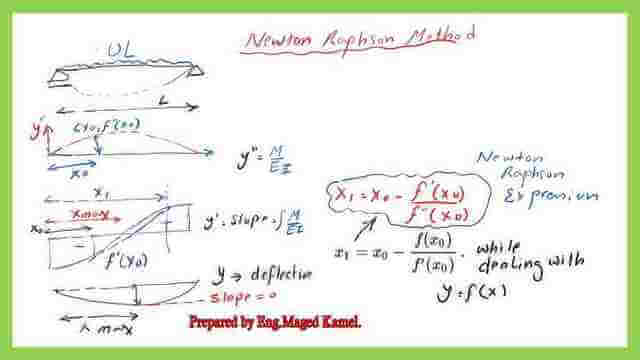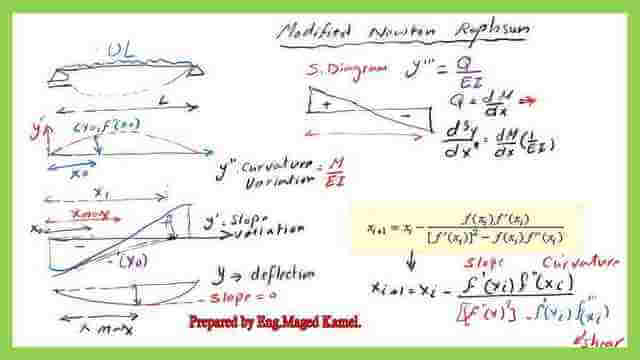Last Updated on March 21, 2024 by Maged kamel
How to use the Newton-Raphson method for structural analysis?
The Newton-Raphson method can be used to make a structural analysis of the beam to enable us to find maximum deflection for a simply supported beam acted upon by a uniformly distributed load. Two approaches will be used the first approach is by using the Newton-Raphson method.
The second approach will be done by using the modified Newton -Raphson Method.
Revisit the Newton-Raphson method-The first approach.
First, we have the y-axis which is located at the left support point, Then we select point A which is apart from the Y-axis by a distance X0, and we make a slope at that point A, shown on the graph of f(x), that slope will intersect with the x-axis at a certain point which will have a horizontal distance of X1 from the y- axis.
Then we will measure or we will calculate the corresponding value of Y, or, f(x1) for that point.
We repeat the process from point B we get another point B’, the second step is we are going to make a slope at point B’, and then the slope will hit again the X-axis at a certain point for that new point we call it point C.
We are Looking for the point for zero y value. We estimate the Y value and so on we are taking several steps that’s why we are approaching the root or the Y value.

The point of maximum deflection for a beam under uniform loading.
As a direct application for this method, for the uniformly distributed load, for example, after making a structural analysis we have the curve of deflection and we are looking to have the point of maximum deflection, which is X maximum distance from the left support.
Here for that curvature for the deflection, we don’t have an intersection for the deflection curve with the X-axis except for x=0 or X =L, that’s why we cannot directly use the Newton-Raphson method by that expression of X1= x0-(f(x0)/f'(x0) to get the distance to the point of maximum deflection.
We use the graph of the slope of the beam to apply the Newton-Raphson method.
We have the slope at the maximum point of deflection will be =0, or the curve of slope intersects the X-axis. That’s why, while checking the slope, y’ curve, where we find that the point of zero or the roots point has the same distance which is Xmax from the left support.
Thus comes the idea of utilizing y’ curve as a major curve to make structural analysis for a beam to get the distance of maximum deflection.
In the next slide, we will see a graph for the expression of Newton-Raphson x1=x0-f(x0)/f'(x0), that equation deals with Y as an f(x) when the Y curve intersects with the x-axis.
But In our case, the Y’ curve is the one that intersects with the x-axis. Now our roots point is at another curve which is y’, the slope curve for the uniformly distributed load on a simply supported beam which is a function of X’.
Accordingly, the terms of the Newton-Raphson method will be modified, as we are going to see in the next slide. Based on the Newton-Raphson Method, x1=x0-f(x0)/f'(x0), while we were dealing with Y as a function of X.

Now our root point is at another curve which is y’ that’s why we are going to replace the original expression, for instance, f(x0) to be replaced with f ‘(x0) and f'(x0) value by f”(x0).
The double integration method expression or elastic curve is y”=M/EI, while y’ is the slope and it can be calculated by the integration of M/EI. for the expression of y, which is the deflection value, is given by double integration of M / EI.
Let us see how we can proceed by using the y’- slope curve.
First, select the X0 distance arbitrarily chosen, this is your starting point, the slope from the left-hand side is negative so we will estimate the f'(x0.).
This time we draw a curve. We draw a slope at that point, then we hit y’ curve by another new point, which is apart x1. The same procedure we have done earlier, for that x1, we are going to estimate y’ of x1 point for the f”(x0), we will proceed to the curve of y” and we get the corresponding f”(x0).

The new expression for the structural analysis of a beam-Numerically- by using the Modified Newton Raphson method.
As a second approach using the modified Newton-Raphson method for the structural analysis, the expression of the equation will be modified as:
Replace f(x) by f'(*x), and f'(x) by f”(x). How we are going to get f”‘(xi)? By recalling the expression that y” which is a curvature variation is =M/EI, when you are going to make differentiation for d2y/dx2, accordingly, you will make differentiation for M/EI, so for d3y/dx3= (dM/dx)/ y/EI, expression. We are familiar with the dM / dX, which is the shear diagram that’s why the d3y/dx3 = Q/Ei, this is our new df3y/dx3.

This is the PDF data used in the illustration of the post.
The next post will include a solved problem for the application of this method, the next post link is the Maximum deflection distance by the Newton-Raphson method.
This is a useful link for a numerical analysis calculator.